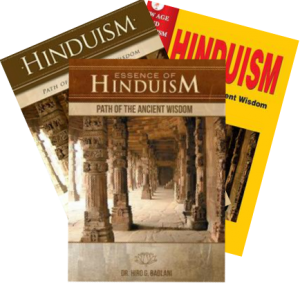Hindu temples are now in all corners of the world. Whenever there is sizeable population of Hindus, the temple activity becomes imperative. The local community takes up the project under the leadership of one or more enthusiastic leaders, and usually the response is encouraging. Undoubtedly, the Hindu community needs these sacred premises, not only so they may be spiritually uplifted but also so that they may maintain their identity and social structure. The temples have become the most important cultural centers around which all other activities are organized.
In many Hindu temples, the multi-deity worship has become a common practice to accommodate the sentiments of different sections of the community. The temples, however, which are organized under the umbrella of the parent institutes, such as ISKCON, the Swaminarayan sect, etc., maintain their individual form and style. In the recently opened Swminayarayan temples, the multi-deity worship has been adopted. Fortunately, in none of the Hindu temples is there a total polarization, nor is the Hindu community rigidly divided on the basis of their temple affiliation. Hindus often visit temples of separate sects and organizations, although they usually have a preference for one of their choice. They normally sponsor their own family functions in the temple of their allegiance.
Hindu temples are established on all five continents. In Africa, these are present in Botswana, Kenya, Nigeria, and South Africa. In Asia, apart from India, Hindu temples are present in Nepal, Pakistan, Bangladesh, Sri Lanka, Malaysia, Indonesia, Singapore, Japan, China, and Cambodia.
Local goverenents in many places are now paying special attention. Police officers in Chicago (and perhaps other cities of US) are being coached to be sensitive to the needs of Hindus. For example, they are asked to remove shoes before entering the temples. In many countries of Europe, apart from UK and also US, there are now not only conventional Hindu temples, but also big Retreats, Ashrams etc. managed often by local white Hindu swamis, priests and monks, and performing very methodically worship and meditation practices, as ordained by Hindu scriptures. After the colonial rule, most of these countries have opened their doors for their past colonial subjects and granted them citizenship, and given them good facilities to estabilish themselves not only financially but also helped them to erect temples and worship centers for their spiritual needs. They also have now very cordial relations with India politically. Sri Ganesha Temple in Berlin is now also performing inter-faith marriages. “If we say ‘No’, they simply run away” says Mr Krishnamurthy, the temple in-charge.
Hindu temples are present in many countries of the Caribbean islands—Barbados, Fiji, Guyana, and Jamaica. In Europe, Hindu temples are established in the UK, Denmark, France, Ireland, and the Netherlands. In North America, there are Hindu temples all across the United States and Canada. In South America, Hindu temples are in Argentina, Bolivia, Brazil, and Chile. Hastinapur, the city of wisdom, in Argentina is a unique temple of its kind. Swaminarayan temples have been established in Africa, the UK, and in many cities in America, such as Boston, Los Angeles, Houston, and Chicago. ISKCON temples are in many places, such as Nigeria, South Africa, Australia, Denmark, Ireland, Netherlands, North America, Argentina, Bolivia, Brazil, Chile, China, and Japan.
Mauritius is situated far south in the Indian Ocean. Technically it is part of Africa, but the population is more than 60 percent Hindus of Indian heritage. There are many Hindu temples. They celebrate Mahasivaratri with great enthusiasm.
The Chinmaya Mission has set up temples, apart from India, in the United States, the UK, Australia, Sri Lanka, and France. Swaminarayan Temple in London occupies a place of pride, as it attracts not only the Hindus but also many persons of other faiths because of its artistic architecture and extensive marble and wooden craftsmanship. The ISKCON temple and Balaji Venkateshwara temples are other important Hindu shrines. The spectacular London Hindu Sri Murugan Temple is popular landmark. There are now Hindu Chaplains in U.K. and U.S.A. armies to serve the needs of Hindu soldiers.
In Australia, the ISKCON and Swaminarayan temples are there along with temples of South Indian origin, such as the Venkateshwar Balaji, Murgan, Balasubramaniam, and Siva temples. Murugan Temple in Sydney, Australia is an important landmark, especially for the Tamil Hindu community. Shiva-Vishnu Temple in Melbourne is very popular.
In Malayasia, Singapore, and other Southeast Asian countries, temples of South Indian origin abound, as more persons from that region of India have migrated there. Hinduism and Buddhism exerted an enormous influence on the civilizations of Southeast Asia and contributed greatly to the development of a written tradition in that area. About the beginning of the Common Era, Indian merchants may have settled there, bringing Brahmans and Buddhist monks with them. These religious men were patronized by rulers who also got converted to Hinduism or Buddhism. Sri Perumal Temple is one of the oldest temples in Singapore. Velmurugan Gnana Muneeswarar Temple, Rivervale Crescent Sengkang in Singapore is also very popular. Singapore encourages religious diversity by celebrating dates and events to each group. Malaysia’s population includes 20 percent Hindus of Dravidian origin. Sri Maha Mariammman temple, founded in 1873, is the Shakta temple, dedicated to goddess Parvati. It is the most famous Hindu temple. Sri Subramaniaswamy Temple, or the Batu Caves Temple, as it is commonly known, is equally popular. Towering besides the stair way with 272 steps at famous Cave Temple, is the 140-foot tall statue of Lord Murugan, the largest in the world. Many devotees and tourists visit this temple, situated high up in the mountain, with elegant steps leading upwards. Impressive Kavadi festival is visible during renowned Thai Pusam. The Arulmigu Sri Rajakaliamman Glass Temple is a major Hindu temple as well as one of the oldest temples in Malaysia.
Indonesia, too, has witnessed enormous temple activity, especially in the province of Java. Sukuh Hindu Temple and Penataran Hindu Temple Complex in Indonesia, along with Temples of Phanomroong and Muangtam in Thailand, and Rishikesh Complex of Ruru Kshetra and Ram Janaki Temple in Nepal are currently on the “Tentative List” of UNESCO World Heritage Convention nominated by their respective countries waiting to be inscribed on World Heritage List. Currently, the World Heritage List is made up of 911 properties “having outstanding universal value”, which includes four Hindu temples: Konark Sun Temple in Bhubhenshwar, Hampi and Pattadakal temples in Karnataka (India) and Prambanan Temples in Indonesia. The Mother Temple of Besakih, or Pura Besakih, in the village of Besakih on the slopes of Mount Agung in eastern Bali, is the most important, the largest and holiest temple of Agama Hindu Dharma in Bali. In Indonesia, there are many Hindu ancient temples, where worship is never performed; these are referred to as dead monuments-as opposite to the ‘live monuments’ in Java and Bali, the ancient temples there where the worship has never ceased. Although worship may be performed in the dead temples, from time to time, their primary use is for the tourist trade. (Similar timples are in Khajurao and other many placess in India.)
In Nepal, which is an overwhelmingly Hindu country, there are many diverse Hindu temples. Pashupatinath Temple in Khatmandu is the most famous Shiva temple in Nepal. Gushmeshwari Shrine is one of the eighteen Sakti Peethas, dedicated to goddess Sati.
Mauritius has the world’s tallest Durga statue -108 feet at Ganga Talao, standing along side another 108 feet statue of Lord Shiva.
A major Swaminarayan Temple is under construction in Abu Dubai, made possible with a gift from Crown Prince of Abu Dubai. (BAPS has now over 1200 temples worldwide).
Pakistan, which had a sizeable Hindu population before the partition in 1947, has a number of diverse Hindu temples. Bangladesh has many Hindu temples of different types. Sri Lanka has a large Hindu population and has many temples of the South Indian style all across the country.
In Mynamar, there is an all-religion 100 acre cremation place where all communities-Buddhists, Hindus, Christians, and even Muslims cremate their dead with their own rites.
Hindu Temples have evolved through millennia, from the most simple structures made of small earthen mounds in the ancient times, to most elegant, highly architectural and artistic structures, housing stunning sculptures, paintings, and imposing “murtis” of deities, through different periods of time.
Hindus have demonstrated greatest interest and importance towards temples, investing heavily in building and maintaining them. Many Hindu temples were systematically destroyed during the Muslim rule; with equal enthusiasm, if not greater, quite a number of them were rebuilt.
In present times, Hindu temples are built in all corners of the world. Many non-Hindus too, visit these temples, sometimes due to their genuine interest in the religion and philosophy, but often also out of curiosity towards the temples’ magnificent architecture, sculptures, and the elegant Murtis. Hindus usually welcome all without any distinction, and no effort is made to convert any one into Hinduism. Hindus too visit the worship places of other communities freely.
Many Hindu temples now have mega assets; often, they build big spacious halls where thousands of devotees, at one time, may attend the religious ceremonies, “Spiritual Talks”, Bhajans and Kirtans etc. Sometimes these spacious halls are also used, with suitable restrictions, for social occasions like “Wedding Functions” etc. by the devotees
Bal-Vihars and Youth Centers, where children and youth may participate and learn about Hindu religion and culture are now becoming common in many Hindu temples, especially those in foreign countries.
Sitting arrangements inside the temples are now mixed; usually chairs/benches are provided for the elderly and handicapped. Individual sitting arrangement on the floor is not yet organized as in some of the Buddhist temples in foreign countries.
Some Hindu temples now provide excellent arrangements for removing and keeping shoes in protected area. Chairs are kept for the devotees to remove and put on shoes comfortably. The shoes are kept in a proper safe area away from rain etc. The shoe room is also inside the main temple area, and a carpet is provided for the devotees to walk safe and warm after removing the shoes. However, there are still many temples that do not have such good facilities.
Hindu temples are now gradually gearing up to organize their programs in a more professional manner. An advance time-table of the events is mailed, and they maintain good punctuality.
Albeit some Hindu temples are now equipped with very modern restrooms; they are also kept clean and hygienic, number of Hindu temples are not yet ready for this.
Many Hindu temples, especially in foreign countries, are now multi-deity, keeping the Murtis of many Hindu gods, with one or more as presiding deities. Even those Hindu temples, which were previously specific about sect, are now accommodating other deities also. Some Hindu temples also good keep the pictures or Murtis of other religion gods/messiahs in a suitable place. Satya Sai Baba temples keep the logo of all the world religions as their emblem. Hindus are usually more liberal in such matters.
NOTE: This chapter is adapted from www.Mandir.com




